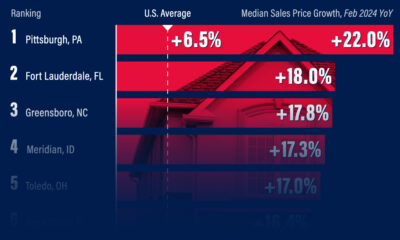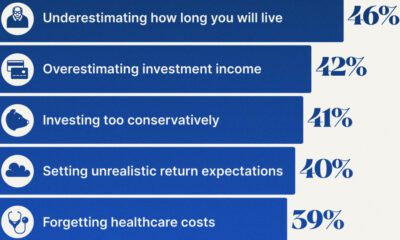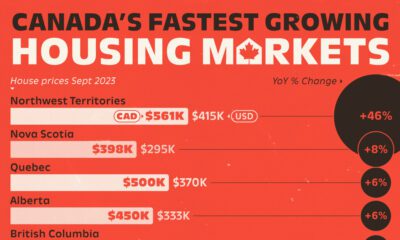Misc
Millennials are Buying Their First Homes, and Here’s What They Want

Millennials are Buying Their First Homes, and Here’s What They Want
Authorities disagree on the exact birth years of the Millennial generation: for example, Pew Research defines Millennials as being born between 1981-1997, the US Census Bureau claims 1982-2000, and the National Association of Realtors says 1980-1995.
However, what all these same sources agree upon is that the Millennials are the largest and most powerful demographic force in North America.
In the United States specifically, Millennials account for a quarter of the entire population with a total of 83.1 million people in the demographic. This is a group that makes up the next generation of investors, continues to struggle with mounting student debt, thinks about money differently, and is now buying homes for the first time.
Marketers in all industries have tried to nail down the preferences of Millennials for some time. Millennials have made things especially more difficult for the real estate industry, as they have delayed common life milestones such as marriage, having children, and home ownership. It is only over the last few years, as Millennials have started to buy homes in significant numbers, that the industry has truly understood what the group wants to see in a home.
Millennial home buyers make up 68% of all first-time home buyers right now, and here’s their average profile: 29 years old, a median income of $76,900, and a typical home purchase (median) of $189,900 for a 1,720 sq. ft home. Of these buyers, 84% believe a home to be a good investment.
Where do Millennials want to buy? About half of the cohort (49%) wants to buy in the suburbs, while 21% would prefer to buy in an urban area. In terms of choosing a specific neighborhood, the most-cited factors affecting Millennials’ decisions were the quality of neighborhood (75%), convenience of getting to job (74%), affordability of home (58%), proximity to friends and family (49%), and quality of the school district (44%).
Today, 32% of all home purchases are made by Millennials, but the reality is that many are still holding off on buying. The major reason for that is student debt, which 54% cited as the biggest obstacle to home ownership. In fact, about one-quarter of all Millennials still live with their parents.
Other reasons cited for not owning a home yet? They include: excessive debt, rising rents, slowing wage growth, tight-lending environment, can’t find home in desired price range, increased college enrollment, and delayed marriage/children.
Original graphic by: UpNest
United States
Charted: What Southeast Asia Thinks About China & the U.S.
A significant share of respondents from an ASEAN-focused survey are not happy about rising American and Chinese influence in the region.

What Southeast Asia Thinks About China & the U.S.
This was originally posted on our Voronoi app. Download the app for free on iOS or Android and discover incredible data-driven charts from a variety of trusted sources.
This chart visualizes the results of a 2024 survey conducted by the ASEAN Studies Centre at the ISEAS-Yusof Ishak Institute. Nearly 2,000 respondents were asked if they were worried or welcoming of rising Chinese and American geopolitical influence in their country.
The countries surveyed all belong to the Association of Southeast Asian Nations (ASEAN), a political and economic union of 10 states in Southeast Asia.
Feelings Towards China
On average, a significant share of respondents from all 10 countries are worried about rising influence from both the U.S. and China.
However, overall skepticism is higher for China, at 74% (versus 59% for U.S.).
| Country | Worried About Growing 🇨🇳 Influence | Welcome Growing 🇨🇳 Influence |
|---|---|---|
| 🇧🇳 Brunei | 58% | 42% |
| 🇰🇭 Cambodia | 66% | 34% |
| 🇮🇩 Indonesia | 57% | 43% |
| 🇱🇦 Laos | 68% | 32% |
| 🇲🇾 Malaysia | 56% | 44% |
| 🇲🇲 Myanmar | 95% | 5% |
| 🇵🇭 Philippines | 81% | 19% |
| 🇸🇬 Singapore | 74% | 26% |
| 🇹🇭 Thailand | 84% | 16% |
| 🇻🇳 Vietnam | 96% | 4% |
| Average | 74% | 27% |
The recently-cooled but still active territorial concerns over the South China Sea may play a significant role in these responses, especially in countries which are also claimants over the sea.
For example, in Vietnam over 95% of respondents said they were worried about China’s growing influence.
Feelings Towards America
Conversely, rising American influence is welcomed in two countries with competing claims in the South China Sea, the Philippines (69%) and Vietnam (55%).
| Country | Worried About Growing 🇺🇸 Influence | Welcome Growing 🇺🇸 Influence |
|---|---|---|
| 🇧🇳 Brunei | 73% | 27% |
| 🇰🇭 Cambodia | 58% | 42% |
| 🇮🇩 Indonesia | 73% | 27% |
| 🇱🇦 Laos | 79% | 21% |
| 🇲🇾 Malaysia | 68% | 32% |
| 🇲🇲 Myanmar | 45% | 55% |
| 🇵🇭 Philippines | 32% | 69% |
| 🇸🇬 Singapore | 37% | 63% |
| 🇹🇭 Thailand | 80% | 20% |
| 🇻🇳 Vietnam | 45% | 55% |
| Average | 59% | 41% |
Despite this, on a regional average, more respondents worry about growing American influence (59%) than they welcome it (41%).
Interestingly, it seems almost every ASEAN nation has a clear preference for one superpower over the other.
The only exception is Thailand, where those surveyed were not a fan of either option, with 84% worried about China, and 80% worried about the U.S.
-

 Culture7 days ago
Culture7 days agoThe World’s Top Media Franchises by All-Time Revenue
-

 Science2 weeks ago
Science2 weeks agoVisualizing the Average Lifespans of Mammals
-

 Brands2 weeks ago
Brands2 weeks agoHow Tech Logos Have Evolved Over Time
-

 Energy2 weeks ago
Energy2 weeks agoRanked: The Top 10 EV Battery Manufacturers in 2023
-

 Countries2 weeks ago
Countries2 weeks agoCountries With the Largest Happiness Gains Since 2010
-

 Economy2 weeks ago
Economy2 weeks agoVC+: Get Our Key Takeaways From the IMF’s World Economic Outlook
-

 Demographics2 weeks ago
Demographics2 weeks agoThe Countries That Have Become Sadder Since 2010
-

 Money1 week ago
Money1 week agoCharted: Who Has Savings in This Economy?














